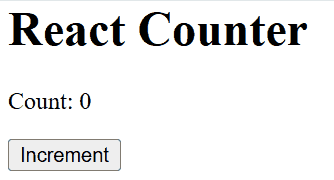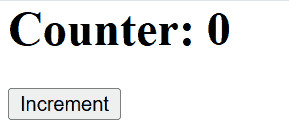ReactJS setState() (original) (raw)
Last Updated : 04 Apr, 2025
**In React, setState() is an essential method used to update the state of a component, triggering a re-render of the component and updating the UI. This method allows React to efficiently manage and render changes in the component's state.
What is setState()?
setState() is a method used to update the state in a React component. When you call this method, React schedules an update to the state and triggers a re-render of the component. The key advantage of using setState() is that it is declarative. Instead of manually manipulating the DOM, you simply inform React of the changes to state, and React handles the rendering for you.
**Syntax
this.setState(updater, callback);
- **updater: An object or a function that represents the changes to be applied to the component's state.
- **callback (optional): A function that is executed once the state has been updated and the component has re-rendered.
**Key Points About setState()
- **State is Immutable: Direct modification of state is not allowed in React. Instead, you use
setState()to change it. - **Triggers Re-render: When
setState()is called, React schedules a re-render of the component to reflect the updated state. - **Merging State: React merges the object passed to
setState()with the current state. If the new state has a key already present in the old state, it updates the value. If not, it adds a new key-value pair. - **Asynchronous:
setState()is asynchronous. The state update doesn’t happen immediately but is scheduled, and React will update the component at an optimal time.
How Does setState() Work?
- **Triggers Re-render: When setState() is called, React schedules an update to the component’s state and triggers a re-render. The updated state is reflected in the component’s output.
- **Merging States: setState() merges the new state with the current state. This is especially useful when you only want to update part of the state, leaving other properties intact.
- **Asynchronous Updates: setState() updates the state asynchronously, meaning the changes don't happen immediately. React batches the updates for performance reasons, and the re-render will happen once all the updates have been processed.
Example Usage of setState()
Incrementing a Counter
JavaScript `
import React, { Component } from 'react'; import './App.css';
class Counter extends Component { constructor(props) { super(props); this.state = { count: 0 }; }
increment = () => {
this.setState({
count: this.state.count + 1
});
};
render() {
return (
<div className="App">
<h1>React Counter</h1>
<p>Count: {this.state.count}</p>
<button onClick={this.increment}>Increment</button>
</div>
);
}}
export default Counter;
`
**Output

Using setState()
**In this code
- setState() is called inside the increment method to update the count state when the button is clicked.
- This triggers a re-render, and the updated count is displayed on the UI.
State Merging in setState()
React automatically merges the state passed to setState() with the existing state. This means that when you update part of the state, React will retain the other parts of the state that weren't changed.
JavaScript `
import React, { Component } from 'react';
class StateMergingExample extends Component { constructor(props) { super(props);
this.state = {
user: {
name: 'Riya Khurana',
age: 30
},
loggedIn: false
};
}
updateUser = () => {
this.setState(prevState => ({
user: {
...prevState.user,
name: 'Sneha Attri'
}
}));
};
toggleLogin = () => {
this.setState({
loggedIn: true
});
};
render() {
return (
<div>
<h1>State Merging</h1>
<p>Name: {this.state.user.name}</p>
<p>Age: {this.state.user.age}</p>
<p>Logged In: {this.state.loggedIn ? 'Yes' : 'No'}</p>
<button onClick={this.updateUser}>Update Name</button>
<button onClick={this.toggleLogin}>Log In</button>
</div>
);
}}
export default StateMergingExample;
`
**Output

Using a Function for setState()
You can also pass a function to setState(), which is useful when the new state depends on the previous state. This function will receive the previous state and props as arguments and should return the updated state.
JavaScript `
import React, { Component } from 'react';
class Counter extends Component { constructor(props) { super(props); this.state = { count: 0 }; }
increment = () => {
this.setState((prevState) => ({
count: prevState.count + 1
}));
};
render() {
return (
<div>
<h1>Counter: {this.state.count}</h1>
<button onClick={this.increment}>Increment</button>
</div>
);
}}
export default Counter;
`
**Output

Function for setState()
**In this code
- When the "Increment" button is clicked, the increment method updates count using setState() with a function that ensures the update is based on the previous state (prevState). This prevents errors from using stale state values.
Updating Attributes
When updating state with setState(), you can modify the attributes of the current state, adding or changing values as needed.
JavaScript `
// Filename - App.js
import React, { Component } from "react";
class App extends Component { constructor(props) { super(props);
// Set initial state
this.state = {
greeting:
"Click the button to receive greetings",
};
// Binding this keyword
this.updateState = this.updateState.bind(this);
}
updateState() {
// Changing state
this.setState({
greeting: "GeeksForGeeks welcomes you !!",
});
}
render() {
return (
<div>
<h2>Greetings Portal</h2>
<p>{this.state.greeting}</p>
{/* Set click handler */}
<button onClick={this.updateState}>
Click me!
</button>
</div>
);
}}
export default App;
`
**Output

**In this code
- **Initial state: greeting is set to "Click the button to receive greetings".
- **Button click: Triggers updateState to change greeting to "GeeksForGeeks welcomes you !!".
- **Binding: updateState is bound in the constructor to ensure proper this context.
- **Rendering: Displays the greeting message and a button that updates the message on click.
Updating state values using props
In React, props are used to pass data from a parent component to a child component. While props themselves are immutable (i.e., they cannot be changed by the child component), they can be used to update the state of the child component. This allows for dynamic, data-driven UIs where child components react to changes in the parent’s data.
JavaScript `
// Filename - App.js
import React, { Component } from "react";
class App extends Component { static defaultProps = { testTopics: [ "React JS", "Node JS", "Compound components", "Lifecycle Methods", "Event Handlers", "Router", "React Hooks", "Redux", "Context", ], };
constructor(props) {
super(props);
// Set initial state
this.state = {
testName: "React js Test",
topics: "",
};
// Binding this keyword
this.updateState = this.updateState.bind(this);
}
listOfTopics() {
return (
<ul>
{this.props.testTopics.map((topic) => (
<li>{topic}</li>
))}
</ul>
);
}
updateState() {
// Changing state
this.setState({
testName: "Test topics are:",
topics: this.listOfTopics(),
});
}
render() {
return (
<div>
<h2>Test Information</h2>
<p>{this.state.testName}</p>
<p>{this.state.topics}</p>
{/* Set click handler */}
<button onClick={this.updateState}>
Click me!
</button>
</div>
);
}}
export default App;
`
**Output

**In this code
- **defaultProps: testTopics contains a list of topics.
- **State: Initially, testName is "React js Test" and topics is empty.
- **updateState(): Updates testName and topics state, rendering the list of topics.
- **listOfTopics(): Maps through testTopics and displays them in a list.
- **Button: On click, updates the state to display the test topics.
setState() is Asynchronous
One of the most important things to understand about setState() is that it is asynchronous. When you call setState(), React doesn't immediately update the state. Instead, it batches multiple state updates and processes them later in an optimal way.
However, React provides a callback function that you can pass to setState() to run code after the state has been updated and the component has re-rendered.
JavaScript `
this.setState( { count: this.state.count + 1 }, () => { console.log('State updated:', this.state.count); } );
`
Best Practices for Using setState()
- **Use Functional setState() for Previous State: Use the function form when updating state based on the previous state.
- **Avoid Direct State Modifications: Always use setState() for updates.
- **Batch Updates: Minimize re-renders by batching state updates.
- **Avoid Mutating State: Create new copies of state objects using spread operators.
- **Use Callbacks: Utilize the callback to handle actions after state updates.
Conclusion
The **setState() method in **React is a fundamental part of how React components manage and update state. Understanding how it works, including state merging, the asynchronous **nature of **updates, and how to use functions for **state updates, is crucial for **building dynamic and **efficient applications. By leveraging setState() properly, you can create responsive, interactive UIs that **react to user interactions and data **changes seamlessly.